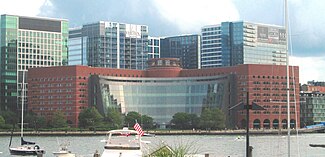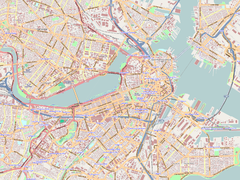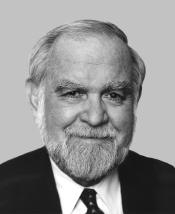
John Joseph Moakley was an American politician who served as the United States representative for Massachusetts's 9th congressional district from 1973 until his death in 2001. Moakley won the seat from incumbent Louise Day Hicks in a 1972 rematch; the seat had been held two years earlier by the retiring Speaker of the House John William McCormack. Moakley was the last Democratic chairman of the U.S. House Committee on Rules before Republicans took control of the chamber in 1995. He is the namesake of Joe Moakley Park in Boston, Massachusetts which was renamed in his honor in 2001 after his death.
Henry Nichols Cobb was an American architect and founding partner with I.M. Pei and Eason H. Leonard of Pei Cobb Freed & Partners, an international architectural firm based in New York City.

Pei Cobb Freed & Partners is an American architectural firm based in New York City, founded in 1955 by I. M. Pei and other associates. The firm has received numerous awards for its work.

Finegold Alexander Architects is an architecture firm based in Boston, Massachusetts. Founded in 1961 as J. Timothy Anderson & Associates, the firm is best known for its work in the field of adaptive reuse.

The Wayne Lyman Morse United States Courthouse is a federal courthouse located in Eugene, Oregon. Completed in 2006, it serves the District of Oregon as part of the Ninth Judicial Circuit. The courthouse is named in honor of former U.S. Senator Wayne Morse who represented Oregon for 24 years in the Senate and was a Eugene area resident. Located in downtown Eugene, the building overlooks the Willamette River.

Douglas Preston Woodlock is a United States federal judge of the United States District Court for the District of Massachusetts. Born in Connecticut, Woodlock graduated from Yale College and worked as a journalist before attending Georgetown University Law Center. After graduating, Woodlock was a lawyer in private practice at the law firm of Goodwin, Procter & Hoar, and had stints at the U.S. Securities and Exchange Commission and U.S. Attorney's Office for the District of Massachusetts. Appointed to the federal bench in 1986, Woodlock presided over a number of noteworthy cases and was a key figure in the construction of the John Joseph Moakley United States Courthouse on the Boston waterfront. He assumed senior status in 2015.

The Frank M. Johnson Jr. Federal Building and United States Courthouse is a United States federal building in Montgomery, Alabama, completed in 1933 and primarily used as a courthouse of the United States District Court for the Middle District of Alabama. The building is also known as United States Post Office and Courthouse—Montgomery and listed under that name on the National Register of Historic Places. In 1992, it was renamed by the United States Congress in honor of Frank Minis Johnson, who had served as both a district court judge and a court of appeals judge. It was designated a National Historic Landmark in 2015.

The James R. Browning U.S. Court of Appeals Building is a historic post office and courthouse building located at San Francisco, California. It is a courthouse for the United States Court of Appeals for the Ninth Circuit. Completed in 1905 as the U.S. Courthouse and Post Office, it was intended to represent the affluence and increasing importance of the United States as it became a world power. The building survived both the 1906 San Francisco earthquake and the 1989 Loma Prieta earthquake.

The Elbert P. Tuttle U.S. Court of Appeals Building, also known as U.S. Post Office and Courthouse, is a historic Renaissance Revival style courthouse located in the Fairlie-Poplar district of Downtown Atlanta in Fulton County, Georgia. It is the courthouse for the United States Court of Appeals for the Eleventh Circuit.

The Everett McKinley Dirksen United States Courthouse, commonly referred to as the Dirksen Federal Building, is a skyscraper in the Chicago Loop at 219 South Dearborn Street. It was designed by Ludwig Mies van der Rohe and completed in 1964. The building is 384 feet (117 m) tall with 30 floors; it was named for U.S. Congressman Everett Dirksen. The building houses the United States Court of Appeals for the Seventh Circuit, the United States District Court for the Northern District of Illinois, the United States Bankruptcy Court, the United States Marshal for the Northern District of Illinois, United States Attorney for the Northern District of Illinois, and local offices for various court-related federal agencies, such as the Federal Public Defender, United States Probation Service, United States Trustee, and National Labor Relations Board. It is one of three buildings making up the modernist Chicago Federal Center complex designed by van der Rohe, along with Federal Plaza, the U.S. Post Office and the Kluczynski Federal Building. Separate from the Federal Plaza, but opposite the Kluczynski Building across Jackson Boulevard, is the Metcalfe Federal Building.

The Gus J. Solomon United States Courthouse is a federal courthouse located in downtown Portland, Oregon, United States. Completed in 1933, it previously housed the United States District Court for the District of Oregon until the Mark O. Hatfield United States Courthouse opened in 1997. The Renaissance Revival courthouse currently is used by commercial tenants and formerly housed a U.S. Postal Service branch. In 1979, the building was added to the National Register of Historic Places as U.S. Courthouse.

The E. Barrett Prettyman Federal Courthouse is a historic building in Washington, D.C. It was built in 1949–50 and currently houses the United States District Court for the District of Columbia, the United States Court of Appeals for the District of Columbia Circuit, and the United States Foreign Intelligence Surveillance Court.

The John Archibald Campbell United States Courthouse, also known as the United States Court House and Custom House, is a historic courthouse and former custom house in Mobile, Alabama. It was completed in 1935. An addition to the west was completed in 1940. It was added to the National Register of Historic Places on October 8, 2008.
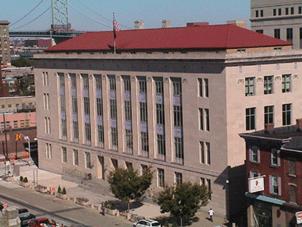
The United States Post Office and Courthouse (1932) and the Mitchell H. Cohen United States Courthouse (1994) house the United States District Court for the District of New Jersey in Camden, New Jersey. The back-to-back buildings are joined by a second story enclosed skyway.
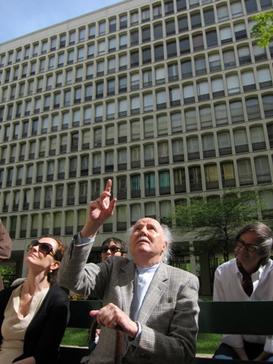
Araldo Cossutta was an architect who worked primarily in the United States. He worked at the firm I. M. Pei & Partners from 1956 to 1973. I. M. Pei has been among the most honored architects in the world. Cossutta was Pei's associate and ultimately his partner in the first phase of Pei's career. He was responsible for some of the firm's best-known designs from that era, including three that have received "landmark" designations in recent years. In 1973 he and Vincent Ponte left Pei's firm to form Cossutta & Ponte, which ultimately became Cossutta and Associates. The new firm designed the Credit Lyonnais Tower in Lyon, France (1977) and the Tower at Cityplace (1988) in Dallas, Texas, among other commissions.

The Orrin G. Hatch United States Courthouse in Salt Lake City, Utah, United States is a federal courthouse located at 351 South West Temple Street in downtown Salt Lake City, on the corner of 400 South and West Temple. It is located behind the Frank E. Moss United States Courthouse. The building houses the United States District Court for the District of Utah. It opened in April 2014.

The United States Courthouse in Seattle, Washington, is a federal courthouse and office building used primarily by the United States District Court for the Western District of Washington. When it opened on August 17, 2004, at a cost of $171 million, it replaced the historic William Kenzo Nakamura United States Courthouse, which has since been transferred to the United States Court of Appeals for the Ninth Circuit. The 23-story, 390-foot (120 m) tall building houses 18 courtrooms and 22 chambers and occupies a full city block along with a landscaped public plaza.

The Theodore Roosevelt United States Courthouse is a courthouse in Downtown Brooklyn, New York City, that houses the United States District Court for the Eastern District of New York. It is across the street from the Federal Building and Post Office, which houses, among other things, the Eastern District of New York's bankruptcy court.
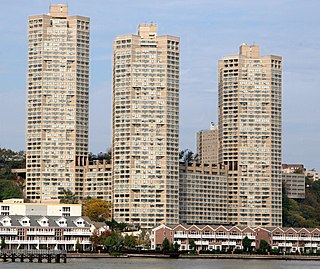
Jordan L. Gruzen (1934–2015) was an American architect.
